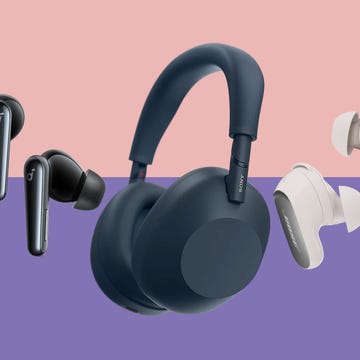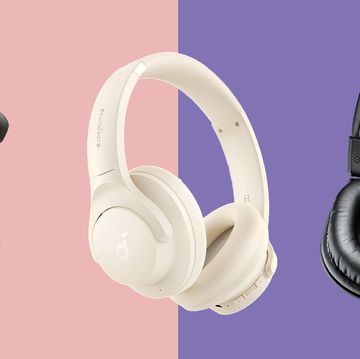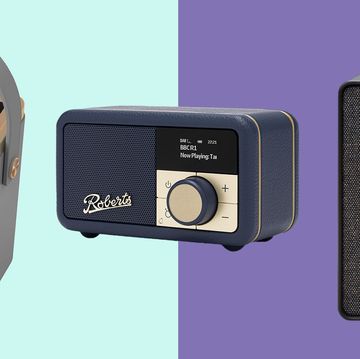I was already very impressed by all the nifty upgrades on offer within the JBL Live Beam 3 earbuds released earlier this year, which come with a compact little screen on their charging case, loads of app-based features, a comfortable fit and great sound. JBL isn’t finished innovating for 2024, though.
Its latest wireless earbuds, the pricey JBL Tour Pro 3, take everything great about the Live Beam 3 and last year’s Tour Pro 2 and upgrade them with just about every conceivable advanced feature available on the market while adding a larger and more capable display to the case, improved drivers and codecs for extra detail in your playlists, levelled-up spatial audio, and improved noise-cancelling.
I’ve reviewed a lot of capable wireless earbuds over the years but this might be the first pair where I’m struggling to work out if anything’s missing. They’re the most full-featured pair to ever arrive on my desk.
What to read next
JBL Tour Pro 3: At a glance
JBL Tour Pro 3: Features
There’s far more to the Tour Pro 3 than a bigger screen with a few extra tricks though. Even if these buds would look similar to their predecessors when compared side by side, there’s a lot new going on inside.
The key things to note are that they’re now capable of head-tracked ”spatial audio” for immersive listening (with upgraded algorithms and performance), they have a dual driver setup for better sound, they have an updated hearing test experience to customise the experience, an updated voice call algorithm and noise reduction when on calls to stop incidental noise around you being heard by whoever you’re talking to.
They also have futuristic support for “Auracast” to transmit to other people on an audio stream (which you can protect with a password). Auracast is a new technology, and it could potentially be used to share music with friends who have headphones with this function. Right now, we're finding it's a bit too new for us to properly test out, though, so we'll update this review when we're able to evaluate how it works.
As mentioned above, it’s hard to think of a single feature that’s missing from the JBL Tour Pro 3’s list of capabilities.
JBL Tour Pro 3: Case, display and battery life
The overall design of the JBL Tour Pro 3 isn’t a complete reinvention compared to the Tour Pro 2, but that larger external display on the case is something you’ll notice. It makes viewing information at a glance easier and the size makes it more smartwatch-like and simpler to use.
The updated interface shows the battery life without you needing to unlock the screen too. This is one of the most significant benefits of the case compared to rivals with no screen. Actual battery percentages are more logical compared to a number of dot lights or different colours to indicate the remaining juice.
JBL is really the only audio brand pushing for meaningful innovations in this area, and this is now a more full-featured display when compared to this year’s Live 3 series. You can use it to control playback (and it’ll now show the artist and track name of what’s playing), you can change sound and equaliser settings, immersive audio functions, noise control modes, your own custom wallpaper and notification preferences.
It’s also more capable because it works as a wireless audio transmitter, something I’ve seen before in the latest Bowers & Wilkins Pi8 earbuds (and prior versions like the Pi7 S2) and also in the Jabra Elite 10 Gen 2 and Elite 8 Active Gen 2. This is an especially handy feature for listening over your earbuds through an inflight entertainment system or when you’re using equipment at the gym.
The battery life is competitive for this category too. It isn’t notably affected by having a screen on the case, which realistically will only come on for a few seconds each time you change a setting or check the battery levels.
You’ll get eight hours of uninterrupted listening with active noise-cancelling (ANC) or noise-control modes on, and up to 24 hours with the case. This goes up to 11 hours if you’re using the buds with noise control off, and they’ll take two hours to recharge from empty. Overall, it has comparable longevity to its predecessors.
There’s a fast charge ability too, so you’ll get three hours of listening after a quick 10-minute charge, which is ideal if you’re in a hurry and low on battery.
JBL Tour Pro 3: Comfort and control
The option of five different pairs of ear tip sizes and one foam pair in the box means the JBL Tour Pro 3 should be some of the best earbuds for accommodating all ears. I’ve got on very well with the default silicone ear tips in the medium size, but I’ve also tested the foam pair, which delivers much better noise-cancelling performance for high-frequency sounds (more on that later).
Overall, the earbuds themselves are very comfortable to wear for a long time – I’ve found them notably more comfortable than the Tour Pro 2 buds – and they’re great for a secure fit with an excellent passive noise-isolating seal in your ears. That’s true whether using the silicone or foam pairs, too, and I like that you can tell the app which of the materials you’re using and it’ll adapt the sound accordingly.
When it comes to control, I’ve found that I end up using the charging case for changing certain settings, much like I do when using the Live Beam 3 from JBL. It helps for a quick adjustment of spatial audio, the noise-cancellation mode or the volume without you needing to dig out your phone.
The on-bud controls are reasonably straightforward, too, though. By default, a single tap on the left side cycles between noise-cancellation and ambient awareness, with a double tap on this side enabling the excellent “TalkThru” mode (more on that shortly). On the right side, taps control playback and summoning your phone’s voice assistant.
It seems churlish to complain, but I’d like full customisation of these taps rather than particular control schemes, though, and the addition of a swipe gesture for volume would be appreciated – this is super handy on the 2nd-generation AirPods Pro and the Bose QuietComfort Ultra earbuds.
JBL Tour Pro 3: Sound quality
JBL has put a lot of tech towards making the Tour Pro 3 sound much better than the previous generation, and it’s paid off. While I liked the Tour Pro 2, I didn’t find much to remark about the sound compared to most of the brand’s high-end rivals. With this revision, though, JBL has swapped the single dynamic driver of the Pro 2 for a dual-driver system that pairs an 11mm dynamic driver for low notes with a “balanced armature” driver to tackle the higher frequencies.
Even if the jargon doesn’t make sense, all you need to know is that this setup is designed to deliver a better performance across a wide range of frequencies. While not essential for improved sound, the use of multiple drivers is something you’ll see often with speakers where “tweeters” deal with high notes and “woofers” play frequencies below the range the tweeter can manage. In the case of the JBL Tour Pro 3, the benefit is apparent – I can immediately hear a more coherent soundstage and better instrumental separation.
The more I listen, the more I like these buds. They never sound distorted with any frequencies, they put vocals at the forefront and they place all the instruments precisely. They’re improved in every way and deliver the kind of detail, clarity, depth and bass response that puts them deservedly in the conversation with the best-sounding earbuds like the Technics AZ80, Sennheiser Momentum True Wireless 4 and Bowers & Wilkins Pi8.
JBL Tour Pro 3: Sound personalisation and immersion
Just like with the JBL Live Beam 3 and the Nothing Ear, one of the most notable benefits is that this sound performance is also customisable with a personalised hearing test.
I highly recommend going through this process in the JBL Headphones companion app (called the “Personi-Fi audio personalisation”), where you listen to tones from the whole frequency range in your left ear and then your right ear, with you noting when you aren’t able to hear them at the higher or lower end. This works convincingly, and I much prefer the already great sound once personalised to my unique ears.
Another notable improvement? Spatial audio. It’s not just the addition of head tracking that makes this better, it feels substantially more realistic and immersive, and I’d now turn on this mode when watching TV shows and movies to make it feel like the audio is coming from all around my head. The algorithms powering this now feel like they’re matching Apple’s AirPods Pro with the subtlety of the 360-degree sound experience, and I’d use them while watching films on Netflix, Disney+ and Amazon Prime Video.
You can engage Spatial Audio via the case too, so it’s possible to connect to an inflight entertainment system via a cable and use audio retransmission and the spatial mode at the same time – very impressive.
JBL Tour Pro 3: Noise-cancelling
The noise-cancelling with these new buds is improved too. With the Tour Pro 3, you’re getting a high-quality active noise-cancelling (ANC) system that adapts based on your environment to dampen out distracting external sounds. It’ll continually monitor the outside world and any ambient noise that might be getting through to your ears, and it’ll invert the sound waves for a quieter experience where you won’t need to turn up the volume as much on your music.
The ANC performance is excellent by default, with it working just as well against the low rumbles of the London Underground train that I take on my way into work as it does with quietening the higher frequency sounds of my colleagues talking to each other at the office. It works well in busy cafe environments with unpredictable ambient noise, and it only gets better when you use the earbuds with the foam ear tips, as those block even more noise from reaching you.
You can switch to the “TalkThru” mode when you want to keep the earbuds in but hold a conversation. I tested this while ordering my morning coffee and it works perfectly – I quite like that this is a separate mode from the “Ambient Aware” setting too, giving you two levels of transparency at just a few taps away. You’d only need general awareness when using them while walking, but want the full “TalkThru” to mute your playlist when you need to chat with someone.
JBL Tour Pro 3: Price
Getting all the most advanced Bluetooth features, upgraded sound quality and a smart charging case with a screen doesn’t come cheap, though.
The new Tour Pro 3 earbuds cost £279.99, a price that puts them among the most expensive wireless earbuds on the market. They’re now almost £100 more than their Tour Pro 2 predecessors too, so those might feel like the better value option.
Good Housekeeping’s verdict on the JBL Tour Pro 3
If future-facing features and seriously high-fidelity audio matter more to you than a high price, the JBL Tour Pro 3 deserve a spot right at the top of the list of earbuds you’re considering.
They deliver reliability, rock-solid connectivity, a capable charging case with a big screen and audio transmission powers, fantastically rich and detailed sound and highly impressive noise-cancelling and ambient awareness control modes.
I’ve found them comfortable to wear all day long, and almost the only downsides are a larger-than-average charging case and a high price tag, Yes, you’ll have to pay a lot more for these than you would for AirPods Pro, Google Pixel Buds Pro or Samsung’s Galaxy Buds3 Pro. There’s not a lot else on the market that’s this expensive, but when you consider every single feature they deliver, maybe they’re worth it.
Simon Cocks is Good Housekeeping UK’s Technology Editor, overseeing tech shopping content and strategy for the title. He previously also worked across other titles including Esquire UK, Digital Spy, Men’s Health UK and Women’s Health UK.
Simon specialises in testing the latest smart gadgets, home entertainment gear, headphones, speakers, portable chargers, radios, e-book readers and smartphones. He's reviewed top tech products from brands including Google, Apple, Amazon, JBL and Bose.
A magazine journalism graduate from Kingston University in 2014, Simon also worked on the Discovery and Silkroad inflight magazines. He then gained experience writing about entertainment at SFX and Total Film. He also contributed reviews and interviews to TwitchFilm (later ScreenAnarchy), CultBox and Frame Rated.
He joined Good Housekeeping UK as the Editorial Assistant for Special Projects and was part of Good Housekeeping’s Consumer Affairs Team between 2014 and 2019. In this role, he conducted price comparison research, wrote detailed household and money-saving advice guides and edited thousands of in-depth reviews for the Good Housekeeping Institute.
He has focused on technology and gadgets since 2020, where he started by testing out power banks and instant cameras. He writes reviews, roundups, news articles and deals updates, and also covers top tech deals during sales like Amazon Prime Day, Black Friday and Cyber Monday.
When not testing out the latest gizmos, you’ll find Simon either catching up with the newest releases at his local cinema or out shooting with his beloved compact camera.
You can follow Simon on Instagram, on Bluesky, on LinkedIn and on Threads.






















